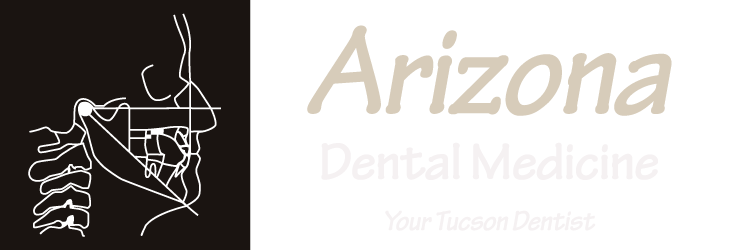Normal Breathing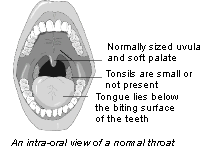
When you breathe normally, air passes through the nose and past the flexible structures in the back of the throat such as the soft palate, uvula and tongue. While you are awake, muscles hold the airway open. When you fall asleep, these muscles relax but, normally, the airway stays open.
 Snoring
Snoring
Snoring is the sound of obstructed breathing during sleep. While snoring can be harmless benign snoring), it can also be the sign of a more serious medical condition which progresses from upper airway resistance syndrome (UARS) to obstructive sleep apnea. (OSA)
What causes snoring?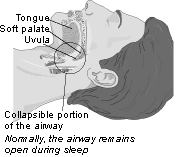
Snoring occurs when the structures in the throat are large and when the muscles relax
enough to cause the airway to narrow and partially obstruct the flow of air. As air tries to passes through these obstructions, the throat structures vibrate causing the sound we know as snoring. Large tonsils, a long soft palate and uvula and excess fat deposits contribute to soft tissue narrowing.
Obstructive Sleep Apnea
When obstructive sleep apnea occurs, the tongue is sucked against the back of the throat.  This blocks the upper airway and air flow stops. When the oxygen level in the brain becomes low enough, the sleeper partially awakens, the obstruction in the throat clears and the flow of air starts again, usually with a loud gasp. People with obstructive sleep apnea (OSA) have disrupted sleep, and low blood oxygen levels. OSA has been associated with cardiovascular problems and excessive daytime sleepiness.
This blocks the upper airway and air flow stops. When the oxygen level in the brain becomes low enough, the sleeper partially awakens, the obstruction in the throat clears and the flow of air starts again, usually with a loud gasp. People with obstructive sleep apnea (OSA) have disrupted sleep, and low blood oxygen levels. OSA has been associated with cardiovascular problems and excessive daytime sleepiness.
The condition known as upper airway resistance syndrome (UARS) lies midway between benign snoring and true obstructive sleep apnea. People with UARS suffer many of the symptoms of OSA but normal sleep testing will be negative.
Sleep apnea has been associated with:
-
Hypertension
-
Stroke
-
Heart
-
Disease
-
Gastric Reflux
-
Sexual Dysfunction
-
Fatigue/Cognitive Dysfunction
-
Depression
How do you know if you have OSA?
The only way to be sure if you have obstructive sleep apnea is to have a sleep test either at home from a qualified sleep physician or in a hospital sleep center.
Take the following test but be sure to visit your physician if you think you have a problem. This test is for daytime
sleepiness not specifically for snoring and apnea. If you score high on the test be sure to visit your physician or dentist.
Please feel free to print this test, fill it out and take with you to your physician.
The Epworth Test
How likely are you to doze off or fall asleep in the following situations?
Choose the most appropriate number for each situation:
0 = would never doze
1 = slight chance of dozing
2 = moderate chance of dozing
3 = high chance of dozing
Activity Score
| Sitting and reading | |
| Watching TV | |
| Sitting, inactive in a public place (theater, meeting) | |
| As a passenger in a car for an hour without a break | |
| Lying down to rest in the afternoon when circumstances permit |
|
| Sitting and talking to someone | |
| Sitting quietly after lunch without alcohol | |
| In a car, while stopped for a few minutes in traffic | |
|
TOTAL |
A score of 9 or above indicates you may be having a problem with daytime sleepiness but below 9 does not necessarily mean that you don’t have a problem. See your healthcare professional for advice if you snore, have been told that you awake gasping for breath or if you are sleepy during the day.
Therapy
There are several ways to treat snoring and sleep apnea. The most common is with a device called a CPAP machine. CPAP stand for continuous positive air pressure. It is usually applied through a tube to a mask that covers the nose. The air pressure that is generated splints the structures in the back of the throat holding the airway open during sleep.
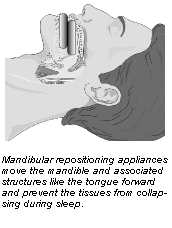 Treatment can also be accomplished with surgery to the soft palate, uvula (that thing that hangs down from the roof of your mouth), and tongue to eliminate the tissue that collapses during sleep. More complex surgery can reposition the anatomic structure of your mouth and facial bones but this is done only in extreme cases.
Treatment can also be accomplished with surgery to the soft palate, uvula (that thing that hangs down from the roof of your mouth), and tongue to eliminate the tissue that collapses during sleep. More complex surgery can reposition the anatomic structure of your mouth and facial bones but this is done only in extreme cases.
Oral appliances that treat snoring and obstructive sleep apnea are small plastic devices, worn in the mouth, similar to orthodontic retainers or sports mouthguards. Oral appliance therapy involves the selection, design, fitting and use of a specially designed oral appliance that, when worn during sleep, maintains an opened, unobstructed airway in the throat.
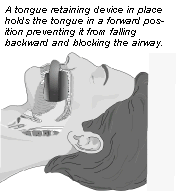 Currently, there are over 40 different types of oral appliance available. Oral appliances may be used alone or in combination with other means of treating OSA, including general health and weight management, surgery or nasal continuous air pressure (CPAP).
Currently, there are over 40 different types of oral appliance available. Oral appliances may be used alone or in combination with other means of treating OSA, including general health and weight management, surgery or nasal continuous air pressure (CPAP).
Oral appliances work in several ways:
-
By repositioning the lower jaw, tongue, soft palate and uvula
-
By stabilizing the lower jaw and tongue
-
By increasing the muscle tone of the tongue
Dentists with training in oral appliance therapy who are familiar with the various types and designs of appliances can determine which one is best suited for your specific dental and medical conditions. The dentist will work with your physician as part of the medical team in your diagnosis, treatment and on-going care. Oral appliance therapy can take from several weeks to several months to complete. Even after the intial phase of treatment is complete, your dentist will continue to follow you to be sure that treatment remains successful and to evaluate the response of your teeth and jaws.
Advantages of Oral Appliance Therapy
Oral appliance therapy has several advantages over other forms of therapy:
Oral appliances are comfortable and easy to wear. Most people find that it only takes a couple of weeks to become acclimated to wearing the appliance.
Oral appliances are small and convenient making them easy to carry when traveling.
Treatment with oral appliances is reversible and non-invasive.
If you are looking for a great Tucson Dentist, give us a call today!
